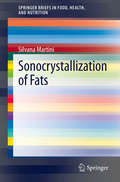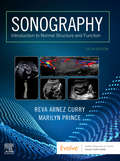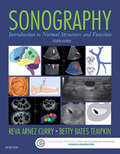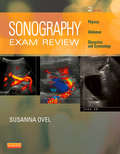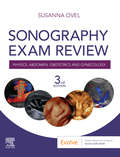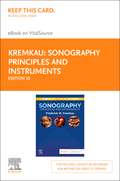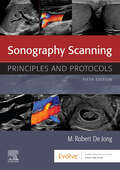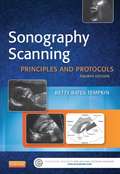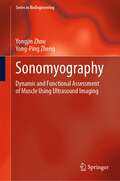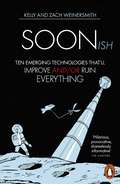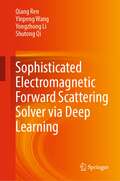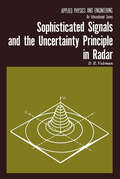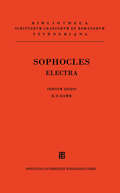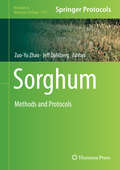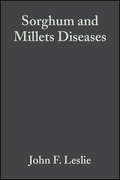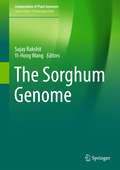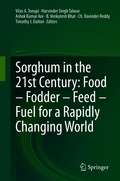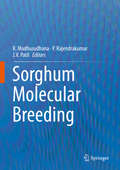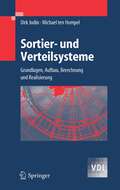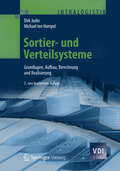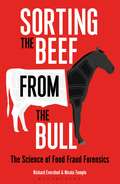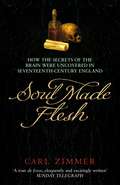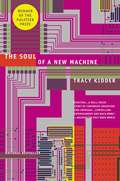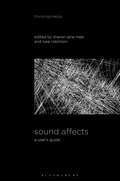- Table View
- List View
Sonocrystallization of Fats (SpringerBriefs in Food, Health, and Nutrition)
by Silvana MartiniSonocrystallization of Fats will summarize the latest research efforts and discoveries in the relatively new area of sonocrystallization of edible lipids. Ultrasound has been used extensively in the past to induce the crystallization of molecules. Until recently, however, very little work has been done using power ultrasound to induce the crystallization of edible lipids and understand how the phenomena applies in these systems. Power ultrasound is used in fats to induce their crystallization and to generate small crystals, which ultimately result in a harder material. Since the elimination of trans-fats from food products, novel processing technologies have been sought to improve the functional properties of low saturated, no-trans lipids. Power ultrasound can be used as a new processing condition to modify the crystallization of fats and tailor their functional properties to specific food uses. This Springer Brief will describe recent research performed in the area of sonocrystallization of fats and the possible application in the food industry. An overview of ultrasound theories will be presented at the beginning of the book followed by a brief description of the uses of power ultrasound in the food industry. Description of recent research in the area of fat sonocrystallization and detailed information regarding the experimental conditions used, such as type of equipment and ultrasound settings, will be presented. The book will end with a description of the future trends in sonocrystallization of fats in the food industry.
Sonography E-Book: Introduction to Normal Structure and Function
by Reva Arnez Curry Marilyn PrinceWithout a deep understanding of what normal anatomy looks like in ultrasound images, you may have a tough time recognizing abnormalities. Thankfully Sonography Introduction to Normal Structure and Function, 5th Edition provides the firm grounding in normal anatomy and physiology that you need from an ultrasound perspective. This highly visual text uses a wealth of ultrasound images accompanied by labeled drawings with detailed legends to increase your comfort with normal anatomy as it appears during scanning. Its consistent chapter format also makes the content easy to navigate and reinforces standard protocols for scanning each area of the body.Highly visual content leads with images and uses narrative to support those visuals.Consistent organization features a standardized heading scheme to aid students when searching for information.Quality control protocol information helps students recreate the most optimal scanning settings and techniques.NEW! Chapter on musculoskeletal sonography covers the latest use of ultrasound technology to visualize muscle, tendon, and ligament anatomy.NEW! Chapter devoted to pediatric sonography introduces students to the knowledge needed to work in this nascent specialty.NEW! Coverage of 5D technology familiarizes students with automated volume scanning.NEW! Updated content reflects the latest ARDMS standards and AIUM guidelines.NEW! More than 100 new and updated sonograms and line drawings give students a better picture of what they should see in scans.
Sonography - E-Book: Introduction to Normal Structure and Function
by Reva Arnez Curry Betty Bates TempkinWithout a thorough knowledge of the appearance of normal anatomy, you may have a tough time recognizing abnormalities in ultrasound images. Get a firm grounding in normal anatomy and physiology from an ultrasound perspective with Sonography: Introduction to Normal Structure and Function, 4th Edition. The new edition of this highly visual introductory text presents a wealth of ultrasound images, accompanied by labeled drawings with detailed legends, to increase your comfort with normal anatomy as it appears during scanning. Its consistent chapter format makes the content easy to navigate and reinforces the discipline of following a standard protocol to scan each area of the body.Detailed line drawings accompany most sonograms to explain what you should notice on each scan. If you do not see the structure, or are uncertain of it on the image, you can look at the diagram for confirmation.Over 1,500 images provide a thorough, visual understanding of sonography.Consistent organization with a standardized heading scheme helps you when searching for information.Content on quality control protocols in the clinical setting shows you how to recreate the most optimal scanning settings and techniques.Evolve resources provide you with additional learning tools.NEW! Full 4-color design incorporates color images within the appropriate chapter to help you understand the concepts without having to flip to the front of the book — and highlights the important points within each chapter.NEW! Three all-new chapters bring you the most up-to-date information on fetal echocardiography, laboratory values, and ergonomics.NEW! Updated sonograms demonstrate the latest and best images from the newest equipment, including 3D and 4D images.NEW! Expanded Test Bank, with new questions for each chapter, provides 1,000 questions on the material.
Sonography Exam Review: Physics, Abdomen, Obstetrics and Gynecology - E-Book
by Susanna OvelBe confident that you can answer any and all questions on your registry exams correctly when you prepare with this complete review. Mosby's Comprehensive Review for General Sonography Examinations provides study resources for all three main exams required for general ultrasound practice: physics, abdomen, and ob/gyn. Each chapter is arranged in table and outline format with 50 review questions at the end of the chapter and a mock exam at the end of each section. Access additional mock exams for each subject area on the companion CD or Evolve site. These exams give you experience with timed test taking in an electronic environment that simulates the actual registry exam experience. With this realistic preview of the exam environment and solid review of the material, you'll be prepared to ace the exams! "..no doubt that this is a worthwhile text which could provide a useful revision platform for sonography students in the UK." Reviewed by Sue Halson-Brown on behalf of RAD Magazine, February 2015Complete preparation for the three general ARDMS exams (physics, abdomen, and ob/gyn)Content review in outline and tabular format provides a quick review of all the material you need to learn, including key terms, anatomy, functions, scanning techniques, lab values, and pathology. More than 2,500 questions in Registry format cover everything you’ll be tested on in the Registry exams. Rationales for answers to mock questions help you understand why an answer is correct or incorrect and increase your comprehension. More than 350 ultrasound scans included in the abdominal and ob/gyn sections prepare you for exam questions that ask you to identify pathology on scans. Color insert with Doppler images of the liver, biliary, and umbilical cord helps you be ready to answer questions related to Doppler imaging. Companion CD provides extra timed, graded mock exams and two entertaining, interactive games: Sonography Millionaire and Tournament of Sonography.
Sonography Exam Review: Physics, Abdomen, Obstetrics and Gynecology E-Book
by Susanna OvelEnsure you can correctly answer any and all questions on their registry exams. Sonography Exam Review: Physics, Abdomen, Obstetrics and Gynecology, 3rd Edition provides the exact review materials you need to pass the three main sonography exams: physics, abdomen, and OB/GYN. Each chapter is arranged in table and outline format with 50 review questions at the end of the chapter and a mock exam at the end of each section. New and revised chapters in this 3rd edition include additional information on salivary glands, musculoskeletal, and male pelvis sonography. Updated information on patient care, imaging techniques, and protocols is also included, and much more!Complete preparation for the three main ARDMS exams: physics, abdomen, and ob/gyn covers the three subject areas required for general ultrasound practice.More than 1,900 questions in registry format — 1,910 in the text and 700 online — allow you to thoroughly prepare for the registry exams using multiple methods of learning.Content review in outline and tabular format offers a quick, concise review of key terms, anatomy, functions, scanning technique, lab values, and pathology for each registry subject.Rationales for answers to mock exam questions are provided to help you understand why an answer is correct and incorrect.More than 350 ultrasound scans are included in the abdominal and ob/gyn sections.Color insert of Doppler images of anatomy and pathology prepares you to answer questions related to Doppler imaging.NEW! Updated coverage of the neck to include salivary glandsNEW! Revised section on the male pelvis to include penile sonography NEW! Additional coverage on imaging techniques and protocols
Sonography Principles and Instruments E-Book: A Qanda Review For The Ardms Sonography Principles And Instrumentation Exam
by Frederick W. KremkauEnhance your imaging skills with the latest sonographic technologies and prepare for the ARDMS SPI certification exam! Sonography: Principles and Instruments, 10th Edition explains how diagnostic ultrasound works and covers the essentials of ultrasound physics and instrumentation, including Doppler imaging, artifacts, safety, and quality assurance. More than 1,300 illustrations include ultrasound scans, helping to demonstrate imaging anatomy, motion, and flow. In simplifying complicated concepts, Dr. Kremkau succeeds where other texts do not. With the right blend of imaging fundamentals, current techniques, and exam practice questions, this book is ideal for both students and experienced practitioners.Emphasis on the fundamentals of physics and sonography prepares you for the ARDMS SPI (Sonography Principles & Instrumentation) certification exam.Coverage of current technology includes the progress made with contrast agents and 3D, along with the more general aspects of transducers and instruments.Straightforward explanations simplify complicated concepts.Over 120 ultrasound scans with a full-color design represent what you will encounter in the clinical setting.Learning objectives at the beginning of each chapter give you a measurable outcome to achieve.Key terms are listed at the beginning of each chapter and bolded in the text for fast and convenient lookup.Key Points are marked with an icon and special type, highlighting the most important information to help you study more efficiently.Bulleted review at the end of each chapter identifies key concepts.End-of-chapter exercises test your knowledge and understanding with a blend of multiple-choice, matching, and true/false questions.Glossary at the end of the book serves as a quick reference to key terms, letting you look up definitions without having to search through each chapter.Appendices offer convenient access to a list of symbols and equations, plus a mathematics review.Student resources on the Evolve companion website enhance learning with videos, a physics review, an image collection, and advanced concepts.NEW! Introduction of the new paradigm for understanding and applying sonographic principles explains how virtual beam-forming and high-speed postprocessing can be used to improve nearly every aspect of sonographic imaging.NEW! UPDATED content reflects questions on the latest American Registry for Diagnostic Medical Sonography (ARDMS) certification exam.NEW and EXPANDED coverage keeps you current with sonographic techniques including elastography, shear wave imaging, acoustic radiation force impulse imaging (ARFI), miniaturization and POCUS, and vector imaging in cardiac and vascular flow studies.NEW! The latest patient safety guidelines are included.Softcover format makes the book easier to carry around and facilitates note taking.
Sonography Scanning E-Book: Principles and Protocols
by M. Robert deJongScanning principles and step-by-step instructions on how to scan and document images helps students improve the quality of sonographic studies and establish standardization and image documentation for physician diagnostic interpretation.Sonographic ergonomics and proper use of equipment helps students avoid occupational injuries.Scanning protocol for pathology provides the criteria for evaluating and documenting abnormal sonographic findings, describing those findings within legal parameters, and relating those findings to the interpreting physician.Key words and objectives at the beginning of every chapter notify students of the pertinent information in the following chapter.NEW! Updated content reflects the latest ARDMS standards and AIUM guidelines.NEW! Thoroughly updated scanning protocols follow AIUM guidelines and offer essential information on patient preparation, transducers, breathing techniques, comprehensive surveys, and required images.NEW! Flexible soft cover makes it easy to take notes and transport content.
Sonography Scanning - E-Book: Principles and Protocols
by Betty Bates TempkinCommonly referred to as the "sonography bible" by many of its past and current users, Betty Tempkin’s Sonography Scanning, 4th Edition is the go-to guide for producing diagnostic sonograms for physicians. Featuring an updated two-color design, this new edition covers the latest ultrasound scanning principles along with step-by-step instructions for scanning and documenting images. The text also incorporates clinical skills, professionalism, image labeling, image techniques, case presentations, handling of ultrasound equipment, and the universal method for scanning and documenting pathologies. The scanning protocols follow AIUM guidelines and provide information on patient prep, transducers, breathing techniques, comprehensive surveys, and required images. Also included are the location of specific vessels or organs, anatomy and physiology, sonographic appearance, and normal variations. "Overall, this book is an excellent resource for novice sonography students, but also provides a useful reference book for the more experienced sonographer." Reviewed by: Dr Vivien Gibbs on behalf of RAD Magazine Date: July 2015Scanning principles and step-by-step instructions on how to scan and document images help users establish standardization and image documentation for physician diagnostic interpretation.Scanning protocols that follow AIUM guidelines provides the essential information on patient prep, transducers, breathing techniques, comprehensive surveys, and required images. The location of specific vessels or organs, anatomy and physiology, sonographic appearance, and normal variations are also included.Sonographic ergonomics and proper use of equipment help sonographers avoid occupational injuries.Scanning protocol for pathology provides the criteria for evaluating and documenting abnormal sonographic findings, describing those findings within legal parameters, and relating those findings to the interpreting physician.Review questions at the end of each chapter give users the ability to self-review.NEW! Transducer location drawings included on images helps users understand exactly where on the body they should scan to produce a particular image.NEW! Musculoskeletal chapter provides musculoskeletal coverage for those sonographers interested in this specialty.NEW! Two-color streamlined design enhances readability and allows for more images on the page.NEW! 300 new images demonstrate superior quality images from the latest state-of-the-art ultrasound equipment.NEW! Pedagogy including key terms and objectives is included at the beginning of each chapter to specify chapter expectations and focus study.
Sonomyography: Dynamic and Functional Assessment of Muscle Using Ultrasound Imaging (Series in BioEngineering)
by Yongjin Zhou Yong-Ping ZhengThis book explains the exciting field of sonomyography (SMG), which makes it possible to use continuous signals detected by ultrasound images in real time to evaluate muscle functions. After an introduction, the book discusses the methods to extract and analyse different SMG signals, including muscle thickness, penetration angle, fascicle length, contraction activity, and muscle cross-sectional areas, etc. It then describes the mono-modal applications of sonomyography: posture recognition, prosthesis control, muscle training, muscle strength (fall risk assessment), fatigue assessment, and the assessment of dysfunctional muscles. The book also shows how to combine sonomyography with additional muscle assessment methods, in particular EMG, MMG, and motion sensors. Lastly, it provides an overview of the potential applications in sport science, rehabilitation, fitness, and elderly health.
Soonish: Ten Emerging Technologies That Will Improve and/or Ruin Everything
by Zach Weinersmith Dr Kelly WeinersmithFrom a top scientist and the creator of the hugely popular web comic Saturday Morning Breakfast Cereal, an illustrated investigation into future technologiesWhat will the world of tomorrow be like? How does progress happen? And why don't we have a lunar colony yet?In this witty and entertaining book, Zach and Kelly Weinersmith give us a snapshot of the transformative technologies that are coming next - from robot swarms to nuclear fusion powered-toasters - and explain how they will change our world in astonishing ways. By weaving together their own research, interviews with pioneering scientists and Zach's trademark comics, the Weinersmiths investigate why these innovations are needed, how they would work, and what is standing in their way.
Sophisticated Electromagnetic Forward Scattering Solver via Deep Learning
by Qiang Ren Yinpeng Wang Yongzhong Li Shutong QiThis book investigates in detail the deep learning (DL) techniques in electromagnetic (EM) near-field scattering problems, assessing its potential to replace traditional numerical solvers in real-time forecast scenarios. Studies on EM scattering problems have attracted researchers in various fields, such as antenna design, geophysical exploration and remote sensing. Pursuing a holistic perspective, the book introduces the whole workflow in utilizing the DL framework to solve the scattering problems. To achieve precise approximation, medium-scale data sets are sufficient in training the proposed model. As a result, the fully trained framework can realize three orders of magnitude faster than the conventional FDFD solver. It is worth noting that the 2D and 3D scatterers in the scheme can be either lossless medium or metal, allowing the model to be more applicable. This book is intended for graduate students who are interested in deep learning with computational electromagnetics, professional practitioners working on EM scattering, or other corresponding researchers.
Sophisticated Signals and the Uncertainty Principle in Radar (Applied Physics and Engineering #4)
by D.E. VakmannThis book is devoted to some of the problems encountered in the theory of sophisticated signals used in radar. The term sophisticated signal is under stood to mean a signal for which the product of the signal duration by the spectrum width substantially exceeds unity. Although it is impossible to draw an exact borderline between simple and sophisticated signals, the term "sophisticated signal" is sufficient to define one of the principal characteristics of modern radar. Recently, various sophisticated signals (frequency-modulated pulses, coded groups, phase-modulated signals, etc.) have found use in radar. This makes it possible to improve the resolution, to ensure simultaneous measurements of the range and range rate of a target, to elecrically scan over finite angular dimensions, etc. Although the realization of such potentialities is associated with substantial difficulties, one can say with certainty that "classical" radar technology, which uses simple signals at constant frequency and duty cycle, yields to more complex methods based on the use of wide-band signals of the sophisticated structure. The properties of radar signals, which characterize the measurement of a target's range and range rate, are described by the Woodward ambiguity function. The role of this function is similar to that of the antenna pattern, i.e., the ambiguity function defines the accuracy and resolution of the range and range rate measurements to the same extent as the antenna pattern de fines the accuracy and resolution of the azimuth and elevation measurements.
Sorghum: Methods and Protocols (Methods in Molecular Biology #1931)
by Zuo-Yu Zhao Jeff DahlbergThis book details sorghum breeding technologies, grain compounds, nutrition and digestibility, biotechnology methods, broad renewable applications and an economic study. Chapters are divided into five review chapters, five case study chapters, and nine protocol chapters providing comprehensive reviews, new study results or state-of-the-art protocols. Written in the highly successful Methods in Molecular Biology series format, chapters include introductions to their respective topics, lists of the necessary materials and reagents, step-by-step, readily reproducible laboratory protocols, and tips on troubleshooting and avoiding known pitfalls.Authoritative and cutting-edge, Sorghum: Methods and Protocols aims to provide useful information and tools to an array of readers looking to research and utilize sorghum.
Sorghum and Millets Diseases
by John F. LeslieThis work is based on the Mexico 2000 meeting under the auspices of ICRISAT (International Crops Research Institute for Semi-Arid Tropics) and INTSORMIL (International Sorghum and Millet Collaborative Research Support Program). Sorghum and millet are very important agronomic crops in many parts of the world, specifically in the semi-arid regions in warm areas. The crops are of great significance in supplying food and feed in the developing areas of Latin America, Africa, and Asia.
The Sorghum Genome (Compendium of Plant Genomes)
by Sujay Rakshit Yi-Hong WangThis book provides insights into the current state of sorghum genomics. It particularly focuses on the tools and strategies employed in genome sequencing and analysis, public and private genomic resources and how all this information is leading to direct outcomes for plant breeders. The advent of affordable whole genome sequencing in combination with existing cereal functional genomics data has enabled the leveraging of the significant novel diversity available in sorghum, the genome of which was fully sequenced in 2009, providing an unmatched resource for the genetic improvement of sorghum and other grass species. Cultivated grain sorghum is a food and feed cereal crop adapted to hot and dry climates, and is a staple for 500 million of the world’s poorest people. Globally, sorghum is also an important source of animal feed and forage, an emerging biofuel crop and model for C4 grasses, particularly genetically complex sugarcane.
Sorghum in the 21st Century: Food – Fodder – Feed – Fuel for a Rapidly Changing World
by Vilas A. Tonapi Harvinder Singh Talwar Ashok Kumar Are B. Venkatesh Bhat Ch. Ravinder Reddy Timothy J. DaltonSorghum is the most important cereal crop grown in the semi-arid tropics (SAT) of Africa, Asia, Australia and Americas for food, feed, fodder and fuel. It is the fifth most important cereal crop globally after rice, wheat, maize and barley, and plays a major role in global food security. Sorghum is consumed in different forms for various end-uses. Its grain is mostly used directly for food purposes. After the release of the proceedings of two international symposia in the form of books “Sorghum in Seventies” and “Sorghum in Eighties”, global sorghum research and development have not been documented at one place. Of course, few books on sorghum have been released that focus on specific issues/research areas, but comprehensive review of all aspects of recent development in different areas of sorghum science has not been compiled in the form a single book. This book is intended to fill in a void to bridge the gap by documenting all aspects of recent research and development in sorghum encompassing all the progress made, milestones achieved across globe in genetic diversity assessment, crop improvement and production, strategies for high yield, biotic and abiotic stress resistance, grain and stover quality aspects, storage, nutrition, health and industrial applications, biotechnological applications to increase production, including regional and global policy perspectives and developmental needs. This book will be an institutional effort to compile all the latest information generated in research and development in sorghum across the globe at one place.
Sorghum Molecular Breeding
by R. Madhusudhana P. Rajendrakumar J. V. PatilThis book provides an up-to-date overview of international research work on sorghum. Its comprehensive coverage of our current understanding of transgenic development in sorghum and the strategies that are being applied in molecular breeding make this book unique. Important areas such as genetic diversity, QTL mapping, heterosis prediction, genomic and bioinformatics resources, post-genome sequencing developments, molecular markers development using bioinformatics tools, genetic transformation and transgenic research are also addressed. The availability of the genome sequence along with other recent developments in sequencing and genotyping technologies has resulted in considerable advances in the area of sorghum genomics. These in turn have led to the generation of a large number of DNA-based markers and resulted in the identification and fine mapping of QTL associated with grain yield, its component traits, biotic and abiotic stress tolerance as well as grain quality traits in sorghum. Though a large volume of information has accumulated over the years, especially following the sequencing of the sorghum genome, until now it was not available in a single reference resource. This book fills that gap by documenting advances in the genomics and transgenic research in sorghum and presenting critical reviews and future prospects. “Sorghum Molecular Breeding” is an essential guide for students, researchers and managers who are involved in the area of molecular breeding and transgenic research in sorghum and plant biologists in general.
Sortier- und Verteilsysteme: Grundlagen, Aufbau, Berechnung und Realisierung (VDI-Buch)
by Dirk Jodin Michael HompelZunehmende Sendungszahlen und kürzere Laufzeiten in engmaschiger werdenden Logistiknetzwerken sind ohne automatische Sortier- und Verteilsysteme nicht realisierbar. Die entstehenden integrierten und hoch entwickelten Materialflusssysteme sind bisher nur punktuell ingenieurwissenschaftlich aufbereitet worden. Das Buch behandelt erstmals übergreifend die aus Sicht der Sortiersysteme relevanten Themen der beteiligten Disziplinen. Neben der systemtechnischen Einordnung und Definition der betreffenden Anlagen, Geräte und Komponenten werden die am Markt und in den Entwicklungslaboren bekannten Lösungen systematisch vorgestellt. Hersteller, Betreiber und Studierende der Logistik und Ingenieurwissenschaften erhalten mit diesem Buch eine breite Palette an Informationen: Von übergreifenden System- und Strategiebetrachtungen über Funktionsbeschreibungen der Geräte und Komponenten bis hin zu den einschlägigen Berechnungsmethoden. Praxisbeispiele realisierter Anlagen ermöglichen den Einblick in die Vielfältigkeit der Anwendungen moderner Stückgutsortier- und Verteilsysteme.
Sortier- und Verteilsysteme: Grundlagen, Aufbau, Berechnung und Realisierung (VDI-Buch)
by Dirk Jodin Michael HompelAngesichts steigender Sendungszahlen und immer kürzerer Lieferzeiten sind Unternehmen auf automatische Sortier- und Verteilsysteme angewiesen. Zu diesen Materialflusssystemen liefern die Autoren erstmals einen umfassenden und disziplinübergreifenden Überblick: über Systeme, Geräte und Komponenten. Sie beschreiben ihre systemtechnische Morphologie, aber auch grundlegende Funktionen und Berechnungsverfahren und stellen Lösungen vor, die am Markt und in den Entwicklungslaboren vorhanden sind. Mit zahlreichen Abbildungen, Skizzen und Tabellen.
Sorting the Beef from the Bull: The Science of Food Fraud Forensics
by Richard Evershed Nicola TempleHorsemeat in burgers was hard to swallow, but there are far more sinister culinary crimes afoot...Chicken eggs that haven't come from chickens, melamine in infant's milk in China, nut shells in spices – these are just some examples of the food fraud that has occurred in recent years. As our urban lifestyle takes us further and further away from our food sources, there are increasing opportunities for dishonesty, duplicity and profit-making short-cuts. Food adulteration, motivated by money, is an issue that has spanned the globe throughout human history. Whether it's a matter of making a good quality oil stretch a bit further by adding a little extra 'something' or labelling a food falsely to appeal to current consumer trends – it's all food fraud, and it costs the food industry billions of dollars each year. The price to consumers may be even higher, with some paying for these crimes with their health and, in some cases, their lives.Sorting the Beef from the Bull is a collection of food fraud tales from around the world. It explains the role of science in uncovering some of the century's biggest food scams, and explores the arms race between food forensics and fraudsters as new methods of detection spur more creative and sophisticated means of committing the crimes. This book equips us with the knowledge of what is possible in the world of food fraud and shines a light on the shady areas of our food supply system where these criminals lurk.
Soul Made Flesh: How The Secrets of the Brain were uncovered in Seventeenth Century England
by Carl ZimmerAt the beginning of Europe's turbulent seventeenth century, no one knew how the brain worked. By the century's close, the science of the brain had taken root, helping to overturn many common misconceptions about the human body as well as to unseat centuries-old philosophies of man and God. Presiding over this evolution was the founder of modern neurology, Thomas Willis, a fascinating, sympathetic, even heroic figure who stands at the centre of an extraordinary group of scientists and philosophers known as the 'Oxford circle'. Chronicled here in vivid detail are their groundbreaking revelations and often gory experiments that first enshrined the brain as the chemical engine of reason, emotion, and madness - indeed as the very seat of the human soul.
The Soul of A New Machine (Modern Library)
by Tracy KidderTracy Kidder's "riveting" (Washington Post) story of one company's efforts to bring a new microcomputer to market won both the Pulitzer Prize and the National Book Award and has become essential reading for understanding the history of the American tech industry. Computers have changed since 1981, when The Soul of a New Machine first examined the culture of the computer revolution. What has not changed is the feverish pace of the high-tech industry, the go-for-broke approach to business that has caused so many computer companies to win big (or go belly up), and the cult of pursuing mind-bending technological innovations.The Soul of a New Machine is an essential chapter in the history of the machine that revolutionized the world in the twentieth century. "Fascinating...A surprisingly gripping account of people at work." --Wall Street Journal
Sound Affects: A User's Guide (Thinking Media)
by Sharon Jane Mee and Luke RobinsonSound Affects: A User's Guide is a collection of sonically-charged concepts ranging from those felt, 'heard' and repeated (silence, the oriental riff, shuffle), to the vocal (whispers, sing, the disembodied voice), to sounds at the threshold (tin/ny, thump, buzz) to sounds beyond the limits of audibility (inaudible tremors, distortion, sub-bass). Sound Affects invites the reader to reflect on the ways that sounds produce affects and the ways that affects can operate as sound. Each of the entries develops a particular perspective on sound and affect through a close analysis of audiovisual and/or sonic objects. The objects chosen not only illustrate the concept in question but also demonstrate how the object encourages us to rethink the relationships between sounds and affects. Influenced by the sound theory of Eugenie Brinkema (2011), the concepts of Sound Affects plot the shift in volume from silence that opens up a space to be heard to the audibly near, from the audibly near to sounds beyond the limits of audibility. Sound Affects is an intellectual adventure for those who theorize and listen. The book can also be enjoyed as a narrative of sounds, its absences and its shifting intensities.
Sound Affects: A User's Guide (Thinking Media)
Sound Affects: A User's Guide is a collection of sonically-charged concepts ranging from those felt, 'heard' and repeated (silence, the oriental riff, shuffle), to the vocal (whispers, sing, the disembodied voice), to sounds at the threshold (tin/ny, thump, buzz) to sounds beyond the limits of audibility (inaudible tremors, distortion, sub-bass). Sound Affects invites the reader to reflect on the ways that sounds produce affects and the ways that affects can operate as sound. Each of the entries develops a particular perspective on sound and affect through a close analysis of audiovisual and/or sonic objects. The objects chosen not only illustrate the concept in question but also demonstrate how the object encourages us to rethink the relationships between sounds and affects. Influenced by the sound theory of Eugenie Brinkema (2011), the concepts of Sound Affects plot the shift in volume from silence that opens up a space to be heard to the audibly near, from the audibly near to sounds beyond the limits of audibility. Sound Affects is an intellectual adventure for those who theorize and listen. The book can also be enjoyed as a narrative of sounds, its absences and its shifting intensities.
